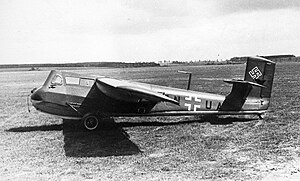
The Heinkel He 111 is a German airliner and bomber designed by Siegfried and Walter Günter at Heinkel Flugzeugwerke in 1934. Through development, it was described as a "wolf in sheep's clothing". Due to restrictions placed on Germany after the First World War prohibiting bombers, it was presented solely as a civil airliner, although from conception the design was intended to provide the nascent Luftwaffe with a heavy bomber.

The Blohm & Voss BV 155 was a German high-altitude interceptor aircraft intended to be used by the Luftwaffe against raids by USAAF Boeing B-29 Superfortresses. Work started on the design as the Messerschmitt Me 155 in 1942, but the project went through a protracted development period and change of ownership, and prototypes were still under test and development when World War II ended.
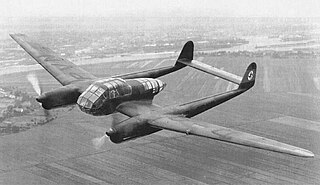
The Focke-Wulf Fw 189 Uhu (Owl) is a twin-engine twin-boom tactical reconnaissance and army cooperation aircraft designed and produced by the German aircraft manufacturer Focke-Wulf. It was one of the Luftwaffe's most prominent short range reconnaissance platforms during the Second World War.

The Dornier Do 217 was a bomber used by the German Luftwaffe during World War II as a more powerful development of the Dornier Do 17, known as the Fliegender Bleistift. Designed in 1937 and 1938 as a heavy bomber but not meant to be capable of the longer-range missions envisioned for the larger Heinkel He 177, the Do 217's design was refined during 1939 and production began in late 1940. It entered service in early 1941 and by the beginning of 1942 was available in significant numbers.

The Blohm & Voss BV 138Seedrache was a trimotor flying boat designed and built by the German aircraft manufacturer Blohm & Voss. It served as the Luftwaffe's primary seaborne long-range maritime patrol and naval reconnaissance aircraft operated by the Luftwaffe during the Second World War.

The Henschel Hs 132 was a World War II dive bomber and interceptor aircraft of the German Luftwaffe that never saw service. The unorthodox design featured a top-mounted BMW 003 jet engine and the pilot in a prone position. The Soviet Army occupied the factory just as the Hs 132 V1 was nearing flight testing, the V2 and V3 being 80% and 75% completed.

The Blohm & Voss BV 238 was a German flying boat, built during World War II. It was the heaviest aircraft ever built when it first flew in 1944, and was the largest aircraft produced by any of the Axis powers during World War II.
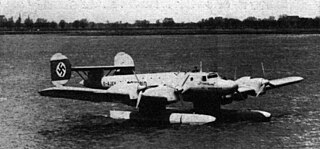
The Blohm & Voss Ha 139 was a German all-metal inverted gull wing floatplane. With its four engines it was at the time one of the largest float-equipped seaplanes that had been built. The inboard engines were mounted at the joint between the inboard anhedral and outboard dihedral wing sections, above the pylon-mounted floats.
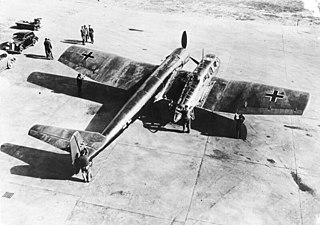
The Blohm & Voss BV 141 was a World War II German tactical reconnaissance aircraft, notable for its uncommon structural asymmetry. Although the Blohm & Voss BV 141 performed well, it was never ordered into full-scale production, for reasons that included the unavailability of the preferred engine and competition from another tactical reconnaissance aircraft, the Focke-Wulf Fw 189.

The Emergency Fighter Program was the program that resulted from a decision taken on July 3, 1944 by the Luftwaffe regarding the German aircraft manufacturing companies during the last year of the Third Reich.

The Blohm & Voss BV 246 Hagelkorn was a guided glide bomb developed to bomb specific targets once it was released.
The Blohm & Voss P 178 was a German jet-powered dive bomber/fighter-bomber of unusual asymmetric form, proposed during World War II.

The Blohm & Voss P 194 was a German design for a mixed-power Stuka or ground-attack aircraft and tactical bomber, during World War II.

The Arado Ar 198 was a prototype reconnaissance aircraft, developed by Arado Flugzeugwerke, with backing from the Luftwaffe, who initially preferred it over the Blohm & Voss BV 141 and the Focke-Wulf Fw 189. However, when flight tests were carried out the aircraft performed poorly and did not impress the Luftwaffe. One aircraft was completed in 1938.

The Blohm & Voss P 170 was a three-engined unarmed fast bomber and ground-attack aircraft project proposed by the aircraft manufacturer Blohm & Voss to the Luftwaffe during the Second World War.
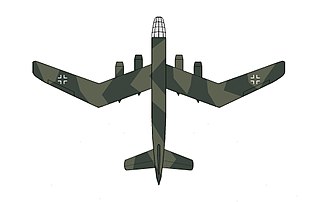
The Blohm & Voss Bv P 188 was a long-range, heavy jet bomber design project by the Blohm & Voss aircraft manufacturing division during the last years of the Third Reich. It featured a novel W-wing planform with variable incidence.
The Blohm & Voss BV 237 was a German proposed dive bomber with an unusual asymmetric design based on the Blohm & Voss BV 141.
The Blohm & Voss P215 was an advanced jet night fighter project by Blohm & Voss during the Second World War. With a crew of three and twin jet engines, it featured a tailless swept-wing layout and heavy armament. An order for three prototypes was received just weeks before the war ended.
The Blohm & Voss P 163 was a design project for an unconventional bomber during World War II. Constructed mainly from steel, its crew were accommodated in large wingtip nacelles, giving it a triple-fuselage appearance. Its propeller drive system was also unusual, with the central fuselage containing twin engines coupled to a front-mounted contra-prop.
The Dornier Do 417 was a twin-engine multirole combat aircraft. Developed in 1942, it resulted from the Luftwaffe's request for a medium bomber, a contest in which Dornier, Junkers, Heinkel, and Blohm & Voss competed. In the end, the Junkers Ju 188 was chosen by the Luftwaffe, and the Do 417 never entered production.
